All About Reclaim Waste
All About Reclaim Waste
Blog Article
The Reclaim Waste PDFs
Table of ContentsReclaim Waste Fundamentals ExplainedThe Buzz on Reclaim WasteThe Single Strategy To Use For Reclaim WasteThe 8-Second Trick For Reclaim WasteAn Unbiased View of Reclaim Waste
Residential sewage waste refers to the waste and products from a household septic storage tank. The appropriate monitoring and disposal of domestic sewer waste call for liquid waste to be transferred to a sewage treatment plant where the appropriate methods and tools are used to cleanse and dispose of waste.
Commercial waste typically consists of prospective hazards, such as flammable products or a combination of fluid and strong waste products, and requires an advanced and in-depth disposal process. The disposal of industrial waste normally involves the filtration of waste prior to transportation to guarantee secure and proper disposal. Hazardous waste is developed from byproducts and overflow of industrial processes and manufacturing.
This type of waste can not use the exact same sewer management transport or procedures as septic or commercial fluids. The industrial waste monitoring procedure needs the assessment and screening of liquid waste before it undertakes the disposal process (liquid waste removal melbourne). Runoff waste is the liquid waste that comes from drainage and excess stormwater in very populated areas or cities
Drainage waste can cause contamination and flooding if not dealt with correctly. Guaranteeing correct waste management can prevent calamities and reduce environmental damage.
Some Ideas on Reclaim Waste You Need To Know
Call PROS Solutions today to find out about our waste management and disposal services and the proper methods to care for the liquid waste you generate.
(https://yoomark.com/content/httpsreclaimwastecomauservices)Do you know what happens to your water when you disengage, flush the bathroom or drain the washing maker? No? Well, it's worth understanding. This supposed 'wastewater' is not only an essential resource yet, after treatment, will certainly be launched to our land, waterways or the ocean. Used water from toilets, showers, baths, kitchen area sinks, washings and industrial procedures is referred to as wastewater.

water used to cool down equipment or tidy plant and equipment). Stormwater, a type of wastewater, is overflow that moves from agricultural and metropolitan locations such as roofs, parks, yards, roads, paths and rain gutters into stormwater drains pipes, after rain. Stormwater flows without treatment directly to local creeks or rivers, at some point reaching the sea.
Our Reclaim Waste Ideas
In Queensland, the majority of wastewater is dealt with at sewage therapy plants. Wastewater is delivered from residential or industrial sites via a system of drains and pump stations, understood as sewage reticulation, to a sewage treatment plant. City governments construct, keep and run most sewage treatment plants. Operators are licensed under the Environmental Management Act 1994 to release treated wastewater at an appropriate environmental criterion right into rivers.
The Division of Natural Resources suggests local governments about managing, operating and preserving sewerage systems and therapy plants. In unsewered areas, city governments may require owners to mount private or household sewage treatment systems to treat residential wastewater from toilets, cooking areas, restrooms and laundries. The Division of Natural Resources authorises making use of house systems when they are proven to be effective.
In some new class, treatment of some stormwater to get rid of litter, sand and crushed rock has actually begun utilizing gross pollutant traps. Wastewater therapy happens in four stages: Gets rid of solid matter.
Uses tiny living microorganisms knows as micro-organisms to break down and get rid of staying dissolved wastes and fine fragments. Micro-organisms and wastes are incorporated in the sludge.
See This Report about Reclaim Waste
Nutrient elimination is not available at all sewer treatment plants because it calls for costly specialised tools. Clear fluid effluent created after therapy may still have disease-causing micro-organisms - liquid waste removal melbourne.

This normally indicates wastewater needs to be treated or impurities gotten rid of before it can be discharged to rivers. The majority of wastewater streams right into the sewage system. Under the Act, city governments provide authorizations and licences for eco relevant activities (Ages) entailing wastewater releases that could have a regional effect. The division administers approvals and licences to ERAs including wastewater releases that could have a local or statewide impact.
10 Easy Facts About Reclaim Waste Explained
Otherwise, samples are taken for research laboratory analysis. Often lots of tests are needed to develop the resource degrees of each of the different toxins such as oils, heavy steels and pesticides in water. Tracking provides accurate information concerning water top quality and can validate that licence conditions are being satisfied. The details obtained with monitoring provides the basis for making water top quality choices.
Report this page